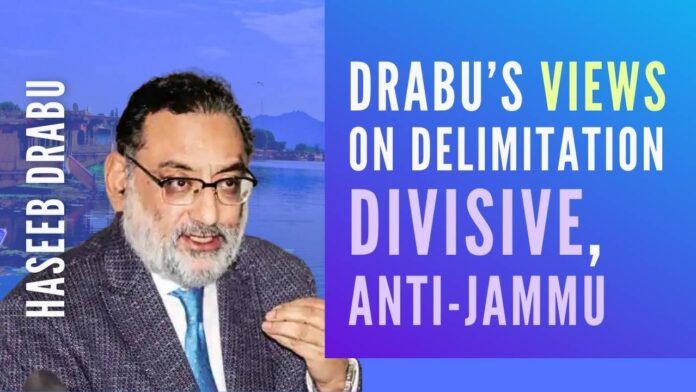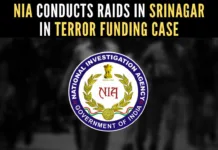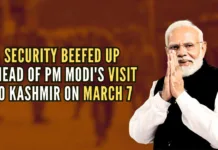
Drabu’s views on J&K delimitation show venom against Jammu sentiments
The loud clamour in Jammu for delimiting assembly constituencies based on the latest population figures or registered voters, land area, topography, and accessibility has stung the Kashmiri leaders of all hues. Convinced that Jammu will get at least 54-56 seats out of 90 and Kashmir only 34-36, if the Delimitation Commission followed the criteria as laid down by the J&K Reorganisation Act, 2019; that the political attitude of the people of Jammu has undergone a radical transformation; that they now know the nature of the problem they face and solution to it; and that they are no longer prepared to lead life the subjects, as opposed to citizens, lead, Kashmiri leaders have devised a two-pronged strategy.
On the one hand, this strategy is calculated to reestablishing the Kashmiri hegemony over Jammu and, on the other, ensuring the defeat of Jammu by pitting Jammu against Jammu. Their whole objective is to mislead and hoodwink the people of Jammu province and again ensure that they do not get representation in the assembly they legitimately deserve and Kashmir controls Jammu fully at all levels and in all spheres and loot and plunder its invaluable natural resources as before.
A Jammu voter will, it axiomatically follows, have one-sixth the electoral influence of his Chenab counterpart. Not even 1 percent of this anomaly has existed in J&K so far.
Take, for example, what the former Finance Minister and PDP’s ideologue Haseeb Drabu has advocated or sought to force down the Jammu’s throat. He has opposed the demand in Jammu seeking appreciation of the land area and other factors while delimiting the constituencies and said that “Area is the not a right criteria; using the area as a criteria for delimitation will have anarchic implications not just for J&K but within Jammu region” as well.
Desperate as he is to reestablish Kashmir’s domination over Jammu, Haseeb Drabu has pitted the people of Kathua, Samba, Jammu, Reasi, and Udhampur districts against the people of Jammu’s other five districts – Doda, Kishtwar, Ramban, Poonch, and Rajouri.
“It might be instructive to go further down this ‘area-based allocation’ line of reasoning. If area as the criteria is applied to the whole of the UT, then it has to be applied to the regions within Jammu Province also,” he has suggested.
To be more precise, Haseeb Drabu has said: “The geography of Jammu is a mix of the Ravi-TawiKandi plains, Sivalik and Pir-Panchal mountains, and the (non-existent) Chenab valley. These distinctive terrains of topography, also overlap with the religious, ethnic, and linguistic affiliations of their inhabitants. Using area as a criteria for apportioning seats 56 seats within Jammu Province will result in the existing 21 out of 37 seats for Jammu plains being reduced to 18 out of 56. Chenab (in this case Doda, Kishtwar, and Ramban districts), which had 9 assembly segments out of 37, will now get 29 out of 56 while Pir Panchal (in this case Poonch and Rajouri districts) will gain 2 seats…What this means is that the one person of Chenab is electorally equal to six people from the Jammu plains! This will be the new model of political empowerment for Jammu and its people. A Jammu voter will, it axiomatically follows, have one-sixth the electoral influence of his Chenab counterpart. Not even 1 percent of this anomaly has existed in J&K so far”.
Haseeb Drabu willfully ignores the fact that the people of Jammu are demanding due representation for Jammu province, which constitutes 62% of the UT’s total land area (61,849 sq km), as against Kashmir’s 38%. People of Jammu province have at no point in time demanded more seats for certain Jammu districts and the people these districts house. Jammu is Jammu and Jammu is divided into 10 districts. We don’t differentiate between our districts and the people who inhabit these districts. Our complaint is the same – under-representation – and our demand is also the same – delimit constituencies strictly as per the prescribed criteria.
Biased Haseeb Drabu not only rejects the land area and other factors and insists on delimitation based on the 2011 (fudged) census alone, but also defends the over-representation of Kashmir in the legislative assembly of the erstwhile J&K State (Kashmir’s 46 seats, as against Jammu’s 37 seats). And to make his spurious and untenable point, he refers to the representation the Jodhpur administrative division and Kutch have in the Rajasthan assembly and Gujarat assembly, respectively.
What exactly has he said in this regard? He has said: “Even though there is a difference, not only is it marginal, it is also well within the stipulated global tolerance levels. In any case, even if the voter per constituency is higher in Jammu than in Kashmir, is this situation unique to Jammu Province? Let us look around the country.
Jodhpur, which is the largest administrative division by area in Rajasthan accounting for 34 percent of the state area, has only 16 percent share in the legislative assembly; 32 MLAs out of 200. Another example is Kutch in Gujarat. It accounts for 21 percent of the total area of the state but has just 3 percent representation in the Gujarat Assembly. On the other hand, Central Gujarat which accounts for 17 percent of the area of the state has a 31 percent share in MLAs”.
J&K is neither Rajasthan nor Gujrat. Jodhpur and Kutch don’t have jihadis. Besides, Ashok Gehlot from Jodhpur was CM of Rajasthan earlier and he is also the CM of the same state at present.
All this must expose the vested interests in Kashmir and establish that their whole formulations are flawed and Valley-centric. And, the people of Jammu are not that naive that don’t understand the implications of what the Kashmiri politicians have been saying and advocating. It is hoped that the Delimitation Commission will not only delimit assembly constituencies based on the latest population figures but will also uphold its July 9, 2021, Jammu commitment: “other factors will also be taken into consideration which includes geographical compactness, public conveniences, accessibility, communication facilities and topography of the areas”.
Note:
1. Text in Blue points to additional data on the topic.
2. The views expressed here are those of the author and do not necessarily represent or reflect the views of PGurus.
- ‘Kashmir My core constituency’: Revisiting July 12, 2003 to understand politics, Omar Abdullah-style - March 15, 2024
- Total deviation from traditional approach: Seven takeaways from PM Modi’s March 7 Srinagar visit - March 9, 2024
- Status of political parties: Why is further J&K reorganization imperative? - March 1, 2024










